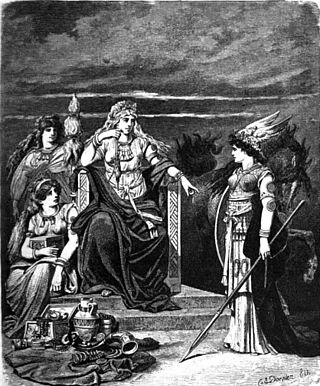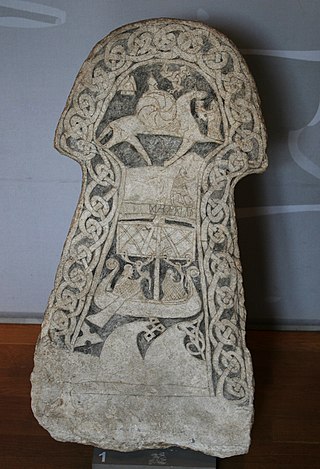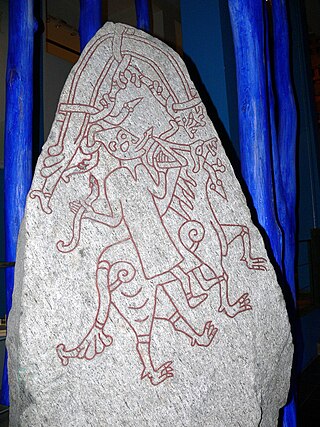This article needs additional citations for verification .(May 2023) |
This is a list of horses in mythology and folklore.
This article needs additional citations for verification .(May 2023) |
This is a list of horses in mythology and folklore.



In Norse mythology, Freyja is a goddess associated with love, beauty, fertility, sex, war, gold, and seiðr. Freyja is the owner of the necklace Brísingamen, rides a chariot pulled by two cats, is accompanied by the boar Hildisvíni, and possesses a cloak of falcon feathers. By her husband Óðr, she is the mother of two daughters, Hnoss and Gersemi. Along with her twin brother Freyr, her father Njörðr, and her mother, she is a member of the Vanir. Stemming from Old Norse Freyja, modern forms of the name include Freya, Freyia, and Freja.

Hel is a female being in Norse mythology who is said to preside over an underworld realm of the same name, where she receives a portion of the dead. Hel is attested in the Poetic Edda, compiled in the 13th century from earlier traditional sources, and the Prose Edda, written in the 13th century. In addition, she is mentioned in poems recorded in Heimskringla and Egils saga that date from the 9th and 10th centuries, respectively. An episode in the Latin work Gesta Danorum, written in the 12th century by Saxo Grammaticus, is generally considered to refer to Hel, and Hel may appear on various Migration Period bracteates.

In Norse mythology, Sleipnir is an eight-legged horse ridden by Odin. Sleipnir is attested in the Poetic Edda, compiled in the 13th century from earlier traditional sources, and the Prose Edda, written in the 13th century by Snorri Sturluson. In both sources, Sleipnir is Odin's steed, is the child of Loki and Svaðilfari, is described as the best of all horses, and is sometimes ridden to the location of Hel. The Prose Edda contains extended information regarding the circumstances of Sleipnir's birth, and details that he is grey in color.

In Norse mythology, the Vanir are a group of gods associated with fertility, wisdom, and the ability to see the future. The Vanir are one of two groups of gods and are the namesake of the location Vanaheimr. After the Æsir–Vanir War, the Vanir became a subgroup of the Æsir. Subsequently, members of the Vanir are sometimes also referred to as members of the Æsir.

In Norse mythology, Gná is a goddess who runs errands in other worlds for the goddess Frigg and rides the flying, sea-treading horse Hófvarpnir. Gná and Hófvarpnir are attested in the Prose Edda, written in the 13th century by Snorri Sturluson. Scholarly theories have been proposed about Gná as a "goddess of fullness" and as potentially cognate to Fama from Roman mythology. Hófvarpnir and the eight-legged steed Sleipnir have been cited examples of transcendent horses in Norse mythology.

In Norse mythology, Hlín is a goddess associated with the goddess Frigg. Hlín appears in a poem in the Poetic Edda, compiled in the 13th century from earlier traditional sources, the Prose Edda, written in the 13th century by Snorri Sturluson, and in kennings found in skaldic poetry. Scholars have debated whether the stanza referring to her in the Prose Edda refers to Frigg. Hlín serves as a given name in Iceland, and Hlín receives veneration in the modern era in Germanic paganism's modern extension, Heathenry.

In Norse mythology, a valkyrie is one of a host of female figures who guide souls of the dead to the god Odin's hall Valhalla. There, the deceased warriors become einherjar. When the einherjar are not preparing for the cataclysmic events of Ragnarök, the valkyries bear them mead. Valkyries also appear as lovers of heroes and other mortals, where they are sometimes described as the daughters of royalty, sometimes accompanied by ravens and sometimes connected to swans or horses.

In Germanic heroic legend and folklore, Fáfnir is a worm or dragon slain by a member of the Völsung family, typically Sigurð. In Nordic mythology, he is the son of Hreiðmarr, and brother of Regin and Ótr and is attested throughout the Völsung Cycle, where, Fáfnir slays his father out of greed, taking the ring and hoard of the dwarf Andvari and becoming a worm or dragon. Fáfnir's brother Regin later assisted Sigurð in obtaining the sword Gram, by which Fáfnir is killed. He has been identified with an unnamed dragon killed by a Völsung in other Germanic works including Beowulf, the Nibelunglied and a number of skaldic poems. Fáfnir and his killing by Sigurð are further represented in numerous medieval carvings from the British Isles and Scandinavia, and a single axe head in a Scandinavian style found in Russia. The story of Fáfnir has continued to have influence in the modern period, such as in the works of J.R.R Tolkien, who drew inspiration from the tale of Fáfnir in his portrayals of Smaug and Gollum.
In Norse mythology, Árvakr and Alsviðr are the horses which pull the sun, or Sól's chariot, across the sky each day. It is said that the gods fixed bellows underneath the two horses' shoulders to help cool them off as they rode.

In Norse mythology, Svaðilfari is a stallion that fathered the eight-legged horse Sleipnir with Loki. Svaðilfari was owned by the disguised and unnamed jötunn who built the walls of Asgard.

Dagr is the divine personification of the day in Norse mythology. He appears in the Poetic Edda, compiled in the 13th century from earlier traditional sources, and the Prose Edda, written in the 13th century by Snorri Sturluson. In both sources, Dagr is stated to be the son of the god Dellingr and is associated with the bright-maned horse Skinfaxi, who "draw[s] day to mankind". Depending on manuscript variation, the Prose Edda adds that Dagr is either Dellingr's son by Nótt, the personified night, or Jörð, the personified Earth. Otherwise, Dagr appears as a common noun simply meaning "day" throughout Old Norse works. Connections have been proposed between Dagr and other similarly named figures in Germanic mythology.

A jötunn is a type of being in Germanic mythology. In Norse mythology, they are often contrasted with gods and other non-human figures, such as dwarfs and elves, although the groupings are not always mutually exclusive. The entities included in jötunn are referred to by several other terms, including risi, þurs and troll if male and gýgr or tröllkona if female. The jötnar typically dwell across boundaries from the gods and humans in lands such as Jötunheimr.

In Scandinavian heroic legend, Grani is a horse owned by the hero Sigurd. He is the horse that Sigurd receives through advice from Odin. Grani is a descendant of Odin's own steed, Sleipnir.

Sól or Sunna is the Sun personified in Germanic mythology. One of the two Old High German Merseburg Incantations, written in the 9th or 10th century CE, attests that Sunna is the sister of Sinthgunt. In Norse mythology, Sól is attested in the Poetic Edda, compiled in the 13th century from earlier traditional sources, and the Prose Edda, written in the 13th century by Snorri Sturluson.
In Nordic mythology, Blóðughófi is the horse of Freyr and is attested in several þulur of horses.
The Horses of the Æsir are horses present in Norse mythology which are ridden by the Æsir. Their main purpose is to be ridden daily to Yggdrasil in order for their riders to pass judgements. They are said to cross Bifröst along their journey. Among them is the famous Sleipnir which is the strongest one. They are mentioned in the Poetic Edda and the Prose Edda.

Odin is a widely revered god in Germanic paganism. Norse mythology, the source of most surviving information about him, associates him with wisdom, healing, death, royalty, the gallows, knowledge, war, battle, victory, sorcery, poetry, frenzy, and the runic alphabet, and depicts him as the husband of the goddess Frigg. In wider Germanic mythology and paganism, the god was also known in Old English as Wōden, in Old Saxon as Uuôden, in Old Dutch as Wuodan, in Old Frisian as Wêda, and in Old High German as Wuotan, all ultimately stemming from the Proto-Germanic theonym *Wōðanaz, meaning 'lord of frenzy', or 'leader of the possessed'.

White horses have a special significance in the mythologies of cultures around the world. They are often associated with the sun chariot, with warrior-heroes, with fertility, or with an end-of-time saviour, but other interpretations exist as well. Both truly white horses and the more common grey horses, with completely white hair coats, were identified as "white" by various religious and cultural traditions.

Norse, Nordic, or Scandinavian mythology, is the body of myths belonging to the North Germanic peoples, stemming from Old Norse religion and continuing after the Christianization of Scandinavia, and into the Nordic folklore of the modern period. The northernmost extension of Germanic mythology and stemming from Proto-Germanic folklore, Norse mythology consists of tales of various deities, beings, and heroes derived from numerous sources from both before and after the pagan period, including medieval manuscripts, archaeological representations, and folk tradition. The source texts mention numerous gods such as the thunder-god Thor, the raven-flanked god Odin, the goddess Freyja, and numerous other deities.

The horse in Nordic mythology is the most important animal in terms of its role, both in the texts, Eddas and saga, and in representations and cults. Almost always named, the horse is associated with the gods Æsir and Vanir, with heroes or their enemies in Nordic mythology. The horse is more than just a means of transport, as it is at the heart of numerous fertility rituals in connection with the god Freyr. Closely associated with the cosmogony of the ancient Germanic-Scandinavians and with profound shamanic symbolism, this psychopomp is entrusted with the task of carrying the dead to Valhalla. The horse pulls the chariot of the sun and moon and lights up the world with its mane. It is linked to many vital elements, such as light, air, water and fire. The male horse is also highly valued in comparison with the mare.
{{cite book}}: |website= ignored (help)